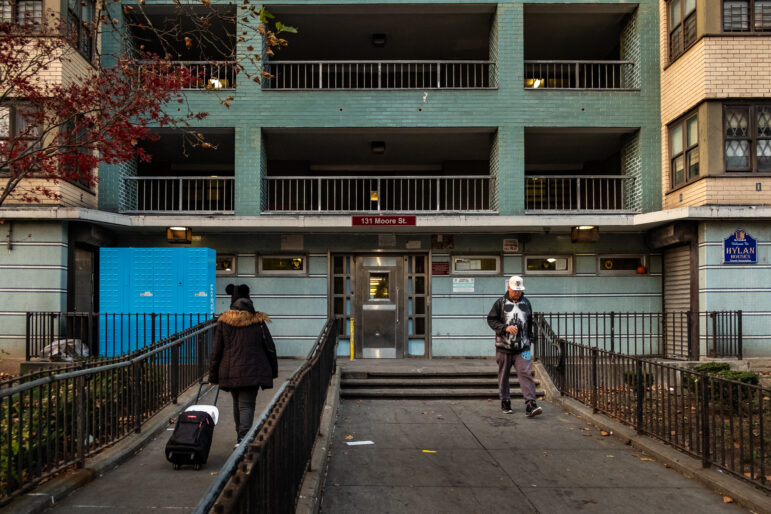In a six-page decision Thursday, a panel of Third Department judges sided with Albany landlords in finding that state property laws preempt and nullify the city’s 2021 good cause eviction protections. The ruling makes the need for similar protections at the state level more urgent, tenant advocates say.

David Brand
Housing activists at a rally for state lawmakers to pass “good cause” eviction legislation in January 2022.On Thursday, one day after Gov. Kathy Hochul signaled disinterest in statewide “good cause” eviction legislation at a press event in Albany, the capital city—first in the state to adopt such tenant protections locally—was dealt a blow in appellate court.
In a six-page decision, a panel of Third Department judges sided with Albany landlords in finding that state property laws preempt and nullify the city’s 2021 good cause eviction protections.
Enshrined in Local Law F, the protections blocked landlords from evicting tenants on the basis of an expired lease, or removing month-to-month tenants who had no lease, so long as they kept up with rent and didn’t engage in illegal or nuisance behavior.
Tenants also had recourse to challenge an eviction for nonpayment if their rent had increased more than 5 percent within a year. A state court judge blocked Local Law F last June, but the city immediately appealed to the higher court.
Despite Albany’s “good intentions,” the panel wrote in Thursday’s decision, Local Law F imposed “restrictions on rights granted to landlords by state law.”
The ruling makes the need for similar protections at the state level more urgent, tenant advocates say. A statewide Good Cause bill, sponsored by Sen. Julia Salazar of Brooklyn and Assemblymember Pamela Hunter of Syracuse, was first introduced in 2019.
If passed, it would prevent landlords from evicting tenants without a designated good cause like failure to pay rent or creating a nuisance. It would also allow tenants to challenge rent increases above a certain level.
The bill has fizzled during budget negotiations since it was first introduced. But this year, tenant advocates point to encouraging developments, including the appointment of Assemblymember Linda B. Rosenthal, a staunch supporter, as housing committee chair.
“Now there’s even more clarity and pressure for [the state] to act,” said Cea Weaver, campaign coordinator for the coalition Housing Justice for All, following Thursday’s decision in Albany.
Robert Magee, deputy corporation counsel for the City of Albany, agreed, urging the state to do “the right thing by passing a statewide good cause eviction law.” He declined to comment on whether Albany planned to appeal to the state’s highest court.
Ben Neidl of E. Stewart Jones Hacker Murphy LLP represented the landlords in the case, who had balked at rules they said would saddle them with indefinite tenancies. He celebrated Thursday’s order in a statement to City Limits.
The decision “vindicates what the plaintiffs and other Albany landlords have said all along: that Albany’s local law wrongfully disrupted the carefully designed state laws that have been calibrated to balance the rights of landlords and tenants alike,” Niedl said.
Landlords have long criticized good cause as an encroachment on property rights, and argued that limits on rents could make property repairs untenable.
Greg Drilling of Homeowners for an Affordable New York, a coalition whose members include the Builders Institute of Westchester and Small Property Owners of New York among others, dismissed the concept Thursday, calling it “an ideologically-driven pursuit by far-left socialists that does nothing to address the housing supply shortage.”
Tenants, meanwhile, see the the good cause eviction defense as a lifeline in the face of steep rent increases. Laurie Buitrago, 57, a member of the Bleecker Terrace Tenant Association in Albany, told City Limits Thursday that she successfully fought back against a proposed 26 percent rent increase last fall—north of $300—by citing the local good cause law to Opus Management Company at her 279-apartment complex, Capitol Crossings.
“I would not have been able to pay it. I would have been forced to move,” she said. “Just the thought of it, I have butterflies in my stomach.”
Now that there is no good cause, she added, “I literally am concerned for a very good portion of the tenants at Capital Crossings.” Opus did not immediately respond to requests for comment.
Outside of Albany, good cause eviction protections are currently in effect in Kingston, Beacon and Poughkeepsie. A similar law in Newburgh was struck down—on the same basis of state law preemption—and has been appealed to the Second Department.
Rich Lanzarone is executive director of the Hudson Valley Property Owners Association, a landlord trade group with members in Kingston. He urged the city to repeal its measure in response to Thursday’s ruling.
“Given that the City of Kingston, also in the Third Department, passed an identical law in 2022, we trust that Kingston officials will do the right thing and repeal this clearly illegal measure,” he said in a statement. “As we have said before, adding multiple layers of regulation is only making a bad situation worse.”
The Third Department took issue with Albany’s authority, not the contents of its law, said Legal Aid Society attorney Ellen Davidson, a strong proponent of statewide protections.
“Their issue with the law was who passed it… whether Albany has the power to do this,” she said. “But New York State does have the power.”
The statewide good cause bill has slightly different conditions than Albany’s did.
For example, tenants would be able to challenge nonpayment eviction filings if their rent increased more than 3 percent in a year, or 1.5 times the annual percentage change in the consumer price index. The law would also exempt owner-occupied residential properties with fewer than four units.
In a 2022 white paper, the Pratt Center for Community Development and the Community Service Society of New York, both proponents of the bill, said it would cover about 1.6 million households, and more than 50 counties would see coverage for 60 percent of their renter households or more.
The organizations used U.S. Census Data to add up unregulated apartments in buildings with four or more units outside of New York City. Within the city, they used the 2017 Housing Vacancy Survey. Apartments in cities with local good cause were not excluded from the count. (The Community Service Society is a City Limits funder.)
Tenants across nearly 1 million apartments in New York City benefit separately from rent stabilization, which ensures lease renewals and limits annual rent adjustments.
Addressing reporters in Albany on Wednesday, Hochul said that she is primarily focused on her proposed Housing Compact, a plan to generate 800,000 new homes across the state in the next decade. It sets housing production targets for towns and cities and would require upzoning for more density around commuter rail stations.
When one reporter asked Hochul if she would consider incorporating good cause legislation to the plan, she responded that “we’ve put forth the plan that we’re going to be working on this year already.”
Pressed for her opinion on the proposal, she replied that “right now, I am focused on getting over the finish line all of the initiatives I have put forth.”
Weaver, of Housing Justice for All, urged Assembly Speaker Carl Heastie and Senate Majority Leader Andrea Stewart-Cousins to act. “Hochul doesn’t get to negotiate New York’s renter protections alone,” she said.
Representatives for Heastie and Stewart-Cousins did not immediately reply to requests for comment.









6 thoughts on “New York’s First ‘Good Cause’ Eviction Law Falls, Ramping Up Push for Statewide Bill”
It is not right for the government to decide on how land lord evict their tenant. If a tenant does not pay Rent.. That tenant needs to leave the apt or get evicted.
Did the Government forget that landlords have bills to pay like water like gas heat and property taxes.? How is the landlord supposed to pay these bills if the tenants don’t pay their rent.. it makes no sense. Landlord worked very hard to have what they have and for Tenan to come and move in and then not pay rent it’s not right.. We the landlords need to step up and let the government know that this is not right. We must have rights to our property..
and if they want to do such a thing. Then maybe we the landlords should not have to pay property taxes to the government at all..
Garcia, I agree 💯 with you (seriously). If this outrageous bill is passed….they need to also enforce it on companies like Black Rock that own thousands of properties throughout the United States. How dare they try to control small mom and pop landlords l!!!??
I agree 100% let us not pay property taxes, water bills, Insurance. What???? dont we have Democracy here or we have Communism where private property is not appreciated. We worked hard to get couple properties so we can have better life when retired now we cannot have control over our properties what have lazy people to leave at our epxenses. Where is the American dream?????
I am a small property owner, real estate agent, former two decade employee of Housing Court, and fourth generation member of my community on Brooklyn.
The bill as written would begin an economic downturn and eventually force out not only moderate and low income renters but small businessmen and property owners. With no incentive to maintain or invest in newly regulated buildings-they will become susceptible to large corporation investment.
This bill is a very short term fix that only helps current residents for a little while. There are millions of units in NYC managed by landlords with no desire to price gouge. I am one of them. But will I invest in another if it is regulated according to this bill. Probably not. But I might sell to the highest bidder and get out of the business. And that is not good for the tenants I rent to.
No where am I seeing any incentive to good landlords. No tax break, no help with maintaining a building in decent condition-so how will that get done? It won’t. And handy men, contractors, painters and plumbers, will have less work in these communities. Grocery stores, laundromats, you name it-will suffer. Moderate and low income residents will suffer the most, by far.
This bill might be well meaning and sounding, but it is not the answer to affordable housing. You don’t get rid of the the bad landlords by forcing out the good ones. Rewrite this bill and it may actually get support across the board and help people, instead of sounding good and gaining political points but actually harming those it proposes to help. Not to mention the city as a whole.
– – – – – – – – –
If NYS wants to address the affordable housing problem why don’t they just give everyone that’s low income section 8? Problem solved. Stop raising property taxes, water, trash, charging rental registration, cfo fees and insurance companies from charging ridiculously high rates. Address the issues YOU are causing before you blame landlords for raising rents.
Because corrupt and inept officials only want to benefit themselves, not tenants, not landlords either.